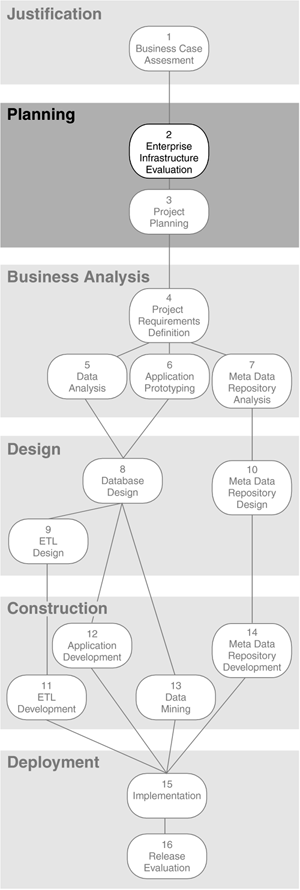|  Chapter Overview An enterprise infrastructure is to BI applications what a transportation infrastructure is to automobile owners . In order to safely and comfortably travel with an automobile, there must be a physical infrastructure, such as roads , bridges, traffic lights, and traffic signs, as well as nonphysical infrastructure, such as standardized traffic rules and their interpretation. For example, without the universal interpretation of the rule that "Green means go, red means stop,"traffic lights would be of no use. Similarly, an enterprise infrastructure consists of two major components : -
Technical infrastructure, such as hardware, middleware, and database management systems (DBMSs) -
Nontechnical infrastructure, such as standards, meta data, business rules, and policies Accordingly, this chapter is divided into two sections ”Step 2, Section A, Technical Infrastructure Evaluation, and Step 2, Section B, Nontechnical Infrastructure Evaluation. The first section covers the following topics: -
Things to consider about technical infrastructure -
The importance of scalability for the hardware platform -
Middleware, with emphasis on DBMS gateways since they are one of the most important middleware components for BI applications -
DBMS requirements for the specific functionality needed to support BI applications -
Brief descriptions of the technical infrastructure activities, the deliverables resulting from those activities, and the roles involved -
The risks of not performing Step 2, Section A The second section, on nontechnical infrastructure, covers the following topics: -
Things to consider about nontechnical infrastructure -
Bad practices and old habits that lead to stovepipe development (automation silos ) -
The need for a nontechnical infrastructure to enable an integrated BI decision-support environment -
The enterprise architecture components: business function model, business process model, business data model, application inventory, and meta data repository -
Enterprise standards for such things as data naming, data quality, and testing -
Brief descriptions of the nontechnical infrastructure activities, the deliverables resulting from those activities, and the roles involved -
The risks of not performing Step 2, Section B  |
